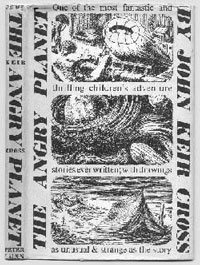THE ANGRY PLANET by John Keir Cross
 I was fascinated by SF from a very early age–I’m not sure why–but there wasn’t very much real science fiction available for kids during the 1950s. I made do with books like Miss Pickerell Goes to Mars and dreamed of the day I’d turn 13 and could check out books from the adult section of the library. (In fact the librarians at the Clinton Public Library gave me–unasked, bless their hearts–an adult card when I turned 12, but that was still a long time coming.)
I was fascinated by SF from a very early age–I’m not sure why–but there wasn’t very much real science fiction available for kids during the 1950s. I made do with books like Miss Pickerell Goes to Mars and dreamed of the day I’d turn 13 and could check out books from the adult section of the library. (In fact the librarians at the Clinton Public Library gave me–unasked, bless their hearts–an adult card when I turned 12, but that was still a long time coming.)
In 1955 when I was ten years old I found The Angry Planet in the children’s section. I think it may at least have shaped–I won’t quite say changed–my life.
Though I read an American edition, The Angry Planet had been published as part of a British series of children’s books in 1945. The editor’s choices were… odd; some of you will understand what I mean when I say that another of the series’ authors was EH Visiak. John Keir Cross, who wrote The Angry Planet, was a Scottish author of some literary reputation; his collection, The Other Passenger, is highly regarded.
The Angry Planet is in form a typical children’s SF novel of the period. A Scottish scientist builds a spaceship in his back yard. He and a writer-friend fly to Mars in it. Three children in their early teens, staying with the writer, stow away on the spaceship.
The atmosphere of Mars is breathable. The planet is inhabited by the Beautiful People–willowy, intelligent folk with a fringe of cilia which serve them as hands–who inhabit glassy cities, and their racial enemies, the Terrible Ones–massive, tentacled monsters; also intelligent but utterly evil.
The humans visit the Beautiful People’s city; one of the children is captured by the Terrible Ones but escapes; and there’s a climactic battle in which the humans aid the Beautiful People against the monstrous foes. The humans return to Earth.
As I said, perfectly standard children’s fare–in form. The execution is another matter.
To begin with, Cross wrote a far too stylistically subtle book for it to appeal to children. The chapters are in the form of diary entries, school essays (literally, How I Spent My Summer Vacation), scientific papers and the like. The skill with which Cross did this is remarkable to me now, but the effect would have been dry and scattered to the target audience. It certainly wasn’t the style that impressed my fifth-grade self, though it obviously didn’t put me off.
The really strange aspect–for a children’s book–is the theme. The Angry Planet is a clear story of the battle between Good and Evil. Evil wins.
The Terrible Ones attack the Beautiful People’s city. The Beautiful People warriors defend themselves bravely but are overwhelmed. The humans watch as a Terrible One in an act of pointless cruelty breaks in half a young female of the Beautiful People whom they’ve befriended. The spear of the chief of the Beautiful People slashes the leader of the Terrible Ones, a damaging but not fatal blow. The Terrible One leaps high and comes down on the chief, smashing him flat. During the battle a volcano erupts; the lava must inevitably destroy anything the Terrible Ones leave.
The humans escape with the only survivor of the Beautiful People’s community, a youth who’s a friend of the children. He sickens and dies on the voyage back; when the corpse starts to decay, they have to put it out the airlock. It floats outside the spaceship’s window all the way to Earth, where the children are forced to watch it burn up in the atmosphere.
So there you have it, the plot of the first real science fiction novel I read. It was only after I came back from Viet Nam that I realized how accurate a mirror The Angry Planet had held up to life.